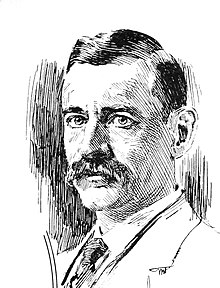Valentine Stuart McClatchy (August 29, 1857 – May 15, 1938) was an American newspaper owner and journalist. As publisher of The Sacramento Bee (now The McClatchy Company) from his father's death in 1883, McClatchy co-owned the paper with his brother Charles K. McClatchy until 1923. After leaving the newspaper business, he became a leading figure in the anti-Japanese movement in California and formed key exclusionary groups to lobby for alien land laws and race-based limits on immigration and naturalization.
V. S. McClatchy | |
|---|---|
 | |
| Born | August 29, 1857 |
| Died | May 15, 1938 (aged 80) |
| Occupation | Journalist |
| Nationality | American |
| Alma mater | Santa Clara University |
Early life and career
editMcClatchy was the son of the prominent nineteenth-century publisher James McClatchy, who was hired by John Rollin Ridge, founder of the Sacramento Bee (known as the Daily Bee when he became editor in 1857). "V.S." graduated from Santa Clara College in 1877, and after the elder McClatchy's death in 1883 he took on joint ownership of the Bee with his brother. "C.K." served as the editor, while Valentine took on the role of publisher. As early as 1915, he began writing about the menace posed by Japanese immigrants, and by 1919 he had largely retired from the paper, turning his efforts instead to publishing a series of anti-Japanese pamphlets. He officially left the Bee in 1923, when C.K. bought him out to obtain sole control of the company.[1] The Sacramento Bee ran upwards of 90 "racially demeaning" anti-Japanese editorial cartoons between 1906 and 1945.[2]
Anti-immigration lobbying
editChina opened migration into California from Asia. This increased the nativism within the United States which culminated into the 1882 Chinese Exclusion Act.[3] With more Asian people coming at the turn of the century, adversaries arose to counter the migration of the Asian people. The first exclusionary league that arose was the Japanese and Korean Exclusion league. With a common and vested interest in keeping the Asiatic peoples from immigrating into America. Two years later, the group renamed themselves to the Asiatic Exclusion League (AEL). The AEL’s purpose was the same as its predecessor the exclusionary group only expanded their nativist goals to affect other Asiatic peoples.
The AEL’s focus was primarily based upon limiting Asiatic migration all together. This was done through amending some of the existing laws like the 1913 California Alien Land Law Act with revisions that made it harder for Asiatic people to reside in California. McClatchy was able to line himself up with nativist groups and take members from the AEL and Native Sons of the Golden West (he was a member of Pacific Parler No. 10[4]), and The Japanese Exclusion League to create an exclusionary group that not only focused on Asiatic Immigration but, also on Mexican and Filipino immigration. The California Joint Immigration Committee (CJIC) formed in 1925 with McClatchy serving as the Secretary of the CJIC. McClatchy was able to surround himself with prominent Californian politicians at the time, such as Attorney General Ulysses S. Webb, Governor Hiram Johnson and Senator James D. Phelan. The CJIC through McClatchy was also able to get aide from other organizations. One of the organizations that assisted the CJIC was the California State Federation of Labor.[5]
McClatchy as the secretary was then able to write and distribute pamphlets published by the CJIC. The pamphlets focused on guarding immigration from countries that were not Anglo-European origin. McClatchy was able to formulate arguments that would only benefit the eugenics belief that had been gaining popularity since the 1917 Immigration Act.[6]
With a new purpose of guarding the Immigration gates against all immigrants the CJIC, through McClatchy, began to adopt precedents through court cases to help create a hierarchy of races. Attempting to use the Thind and Ozawa cases to help differentiate white from the “other.” These cases were able to distinguish asiatic people as a race other than white, however, with immigration from Mexico seemingly increasing post-war; McClatchy was adamant about adopting a test-case for Mexicans to gain a classification of their race to ensure they would not be able to be exempt from the 1924 Immigration Act.[7]
In 1937, he lobbied to strip Kibei, Japanese Americans born in the United States who were sent to Japan to study or visit family for an extended time, of their citizenship if they had lived in Japan for more than a year.[1]
He died of a heart condition on May 15, 1938.[1]
See also
editReferences
edit- ^ a b c Niiya, Brian. "V.S. McClatchy". Densho Encyclopedia. Retrieved 27 August 2014.
- ^ Wildie, Kevin (2013). Sacramento's historic Japantown : legacy of a lost neighborhood. History Press. ISBN 978-1-62619-186-0. OCLC 855581023.
- ^ Daniels, Roger (1974). Racism In California: A Reader in the History of Oppression. New York: Macmillan. p. 55.
- ^ Conmy, Peter Thomas (1942), The history of California's Japanese problem and the part played by the Native Sons of the Golden West in its solution (PDF), Native Sons of the Golden West, p. 5, retrieved May 6, 2022
- ^ Hirobe, Izumi (2001). Japanese Pride, American Prejudice: Modifying the Exclusion Clause of the 1924 Immigration Act. Stanford University Press. pp. 71–72.
- ^ McClatchy, Valentine Stuart (1925). Guarding the Immigration Gates: What Has Been Done What Is Still to Be Done. California Joint Immigration Committee.
- ^ Molina, Natalia (2014). How race is made in America : immigration, citizenship, and the historical power of racial scripts. University of California Press. ISBN 9780520280083. OCLC 898719258.
External links
edit- McClatchy's skeleton brief on "Japanese Immigration and Colonization," submitted to Secretary of State Charles Evans Hughes in 1921 on behalf of the Japanese Exclusion League
- Densho Encyclopedia article on the California Joint Immigration Committee